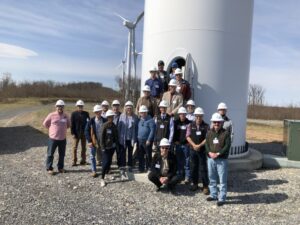Citizens Where We Serve: Renewable Energy’s Long-Term Success Begins in Local Communities

After a fire broke out at a high school in Petersburg, West Virginia, Clearway Energy Group’s Doug Vance sprang into action.
For several weeks before, Vance – wind plant manager for Forward, Lookout, and the Pinnacle Wind Farm in the nearby city of Keyser – had been leading the charge to develop Clearway’s Adopt-A-School Program in partnership with colleagues that manage, maintain, and operate renewable projects across the country. As the program grows, each of Clearway’s utility-scale solar and wind sites will form partnerships with a local school.
After hearing about the fire, Vance reached out to school authorities and was told about serious damage to the roof and rafters of the football field house that destroyed much of the students’ athletic equipment.
“I knew we had to help get those kids back on the field,” said Vance. Clearway was one of many local organizations that made financial contributions to replace gear and equipment and help the team overcome the challenges the fire created.
Clearway’s employee-led contribution and the Adopt-A-School Program are just two examples of a broader effort to invest in the places where we work and live. “Working with communities is a significant part of my job, but that commitment doesn’t stop at our property edge,” said Vance. “We’re part of the community – through thick and thin.”

While the tools for local engagement vary widely from location to location, Pinnacle Wind Farm illustrates two ways in which local engagement is a strategic part of our business and a fundamental building block of the long-term health of our company and the places we work.
First is Pinnacle’s membership in local organizations – including the Mineral County Chamber of Commerce, the Grant County Chamber of Commerce, and the West Virginia Chamber. This focus allows us to stay on top of local developments and be an active participant in the local civic and business community of the places we operate.
Second is Pinnacle’s focus on education. In addition to the Adopt-A-School Program, Pinnacle also welcomes students to shadow Clearway employees and learn about what it’s like to work at a wind farm. This provides valuable job and professional development opportunities for area youth while helping us keep an open line of communication with a community where we work.
Clearway wind turbine technicians are also frequent guest speakers at Eastern West Virginia Community & Technical College, where there is a wind tech training program that helped train some of Clearway’s own employees. And this past spring, Clearway hosted a discussion and tour with local county commissioners and state lawmakers.
At the heart of Pinnacle’s community efforts is its Community Benefit Fund. Recently, the fund distributed tens of thousands of dollars to 18 local nonprofits and community organizations. In the eight years since the fund’s inception, we’ve contributed to dozens of local organizations. This year, we received a record number of grant applications, which were evaluated by a committee made up of eight area residents unaffiliated with the project.
In the coming months, Clearway hopes to begin the process of repowering Pinnacle with new and more efficient turbines. And with the recent WV Siting Council approval of our nearby proposed Black Rock wind project, we are excited to expand the community benefit fund and employment opportunities in the region.
We’ve seen firsthand the many benefits of a strong community affairs strategy, and academic research supports our findings, too. As the Harvard Business Review notes, employee engagement through volunteer work and community involvement contributes to the three Cs (career, community, and cause) that lead to higher retention rates of talented employees. A strong culture of community engagement can also inspire new entrants to the workforce to train for careers in renewable energy, where wind techs and solar installers are among the fastest-growing professions.
There’s no question that comprehensive community engagement like this takes time and effort. It is all hands on deck to build a clean energy future – and investing in the communities we call home is where that important work begins.